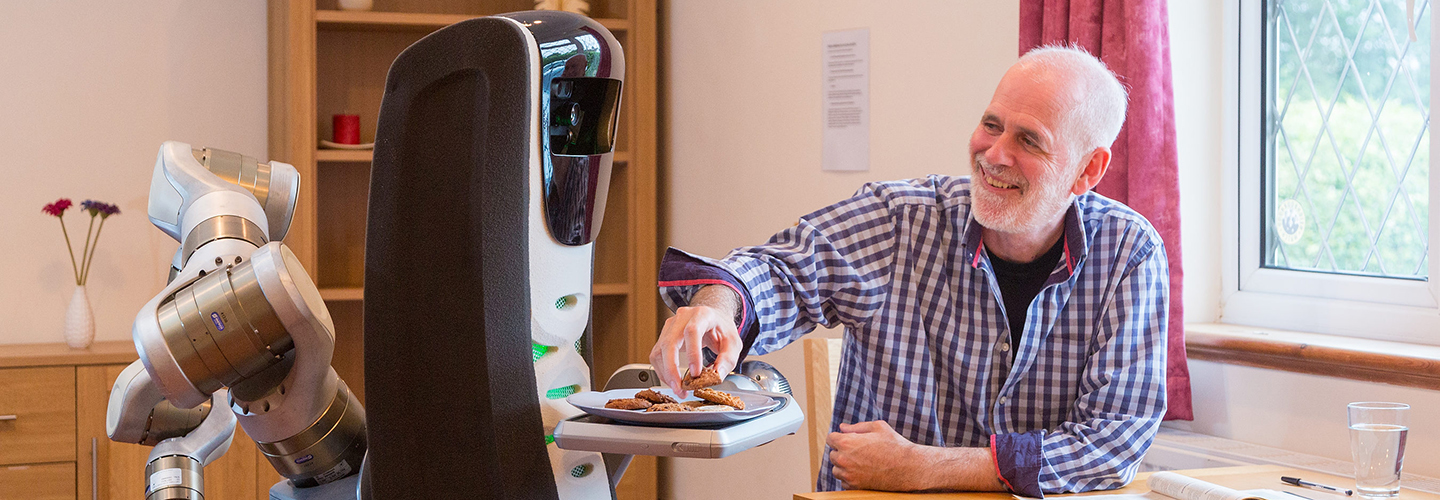Robots for health and social care
From Kaspar the humanoid robot helping children with autism to a suburban house staffed by care robots for assisted living, the University of Hertfordshire’s human-robot interaction studies are exploring innovative care solutions.
Building on more than a decade’s research into how humans and machines interact, the University’s pioneering Adaptive Systems Research Group has developed Kaspar, a child-sized expressive robot that is helping children with autism learn how to socialise, interact and communicate.
Designed to be a safe and predictable learning mediator, Kaspar uses simplified facial expressions, speech and bodily gestures to help children learn fundamental social skills such as imitation and turn-taking. Sensors on the robot’s cheeks, arms, hands and feet mean Kaspar can respond to touch, giving feedback and encouraging certain behaviours to help children learn about socially acceptable tactile interaction. By holding objects such as a spoon, knife and fork, toothbrush or comb, Kaspar also encourages and facilitates pretend play with food and meals, and personal hygiene – areas with great difficulties for some children with autism.
The University team is now using Kaspar in a pilot evaluation for the National Institute for Health Research (NIHR), the research arm of the NHS, to see if and how Kaspar can be introduced as a tool in clinical intervention. The NIHR study – the first of its kind in the UK – is working with 40 children aged between five and 10 years old who have only recently been diagnosed with Autism Spectrum Disorder.
The two-year study is comparing the social skills of those children who interact with Kaspar and a therapist, and those who interact with a therapist only. The initial study is also helping to establish the feasibility of expanding the trial to some 250 children, and potentially using Kaspar across the NHS.
“In previous studies with Kaspar there have been promising results that show it improves the development of communication and social skills in children with autism, particularly those of a young age. We want to build on that success in a clinical environment.”
This innovative approach is an excellent example of our researchers pushing boundaries to improve lives….This trial could lead to real impact for families and children across the country.
Nicola Blackwood,
Then Minister for Public Health and Innovation, speaking at the [April 2017] announcement of the NIHR-funded trial
Video from Reuters article exploring Kaspar.
Robot House
Robotic companions also have the potential to benefit older people or people with disabilities, who may need physical or cognitive assistance in their homes. To explore this fully, the University adapted a three-bedroomed residential house into a unique research facility for human-robot interaction.
Robot House is a smart home which, alongside its fully-equipped kitchen, sofas, dining table and chairs, is equipped with the latest generation of robotics platforms, including state-of-the-art care robots for assisted living. Cameras installed in the ceiling and sensors embedded in the environment and domestic appliances monitor activity in the house, and relay the information to the robots so they can respond by offering personalised physical, social and cognitive support to their human ‘co-residents’.
New robots are now being integrated into the Robot House, and the upgraded facility, Robot House 2.0, will allow research into a broader range of human-robot interaction scenarios. Other research institutions will be able to use the house to develop, evaluate and validate smart home and robotics technology.
Robot House 2.0 will also allow industry to develop and evaluate products aimed at the home environment and enable social science and psychology-oriented research into issues such as ethics and technology acceptance.
The real-life setting allows researchers to explore new ways of making collaboration between robots and humans more effective and safer and looks towards a future where robotic companions may play a greater role in caring for older people.
